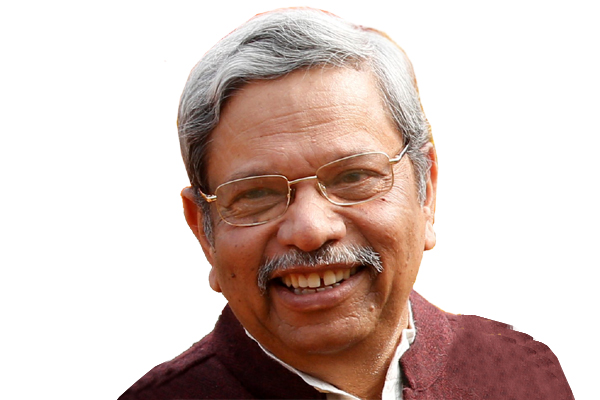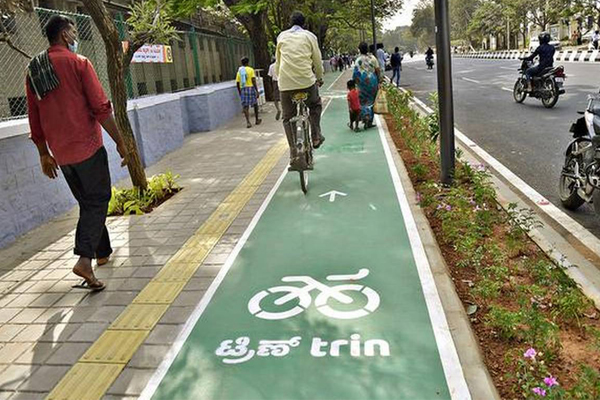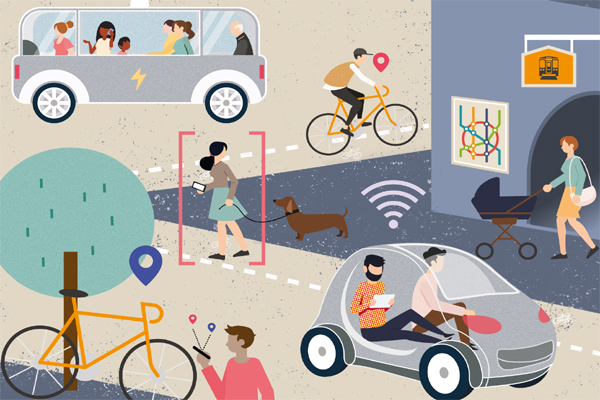
Since the adoption of the 2030 Agenda for Sustainable Development by United Nations Member States, each of them is making efforts to fulfill the 17 Sustainable Development Goals (SDGs). India has also been implementing various measures to achieve SDGs. The SDG 11.2, which overall focuses on sustainable, affordable, safe and accessible transport for all, needs some major policy shifts and adoption of innovations to be fulfilled in India. Here’s how Dr O P Agarwal, Chief Executive Officer, World Resources Institute, describes the status of SDG 11.2 in India.

Dr-O-P-Agarwal
Chief Executive Officer
World Resources Institute
In your opinion, is India on the right path to meet the broad objective envisaged under SDG 11.2? What key actions, and at which levels, should be taken to achieve the envisaged objectives?
The adoption of the National Urban Transport Policy in 2006 was a turning point in India’s approach to urban mobility. This policy prioritised investments in public transport over those in road widening and flyovers. Public transport investments have gone up significantly, thereby putting India on the right track to meet the objectives of SDG 11.2. However, an impression seems to have since emerged that large and stand-alone high-cost projects will be sufficient to provide the needed access to jobs, education, healthcare and other basic needs. Unfortunately, this is not correct and an aggressive effort is needed to ensure a more holistic approach to urban mobility planning.

In order to provide a solid framework of transport-related indicators and apt data to monitor progress, what structures need to be set up to derive final transport statistics estimates at the national level?
It is true that transport-related data is extremely weak in India. There is no systematic effort at collecting and managing such data. This has constrained scientific planning and led to the unreliable estimation of demand for several investment projects. This is evident from the consistent shortfalls we have seen in the ridership estimates of several metro rail projects. The problem has been further compounded by the belief that real-time data collected through IT-based systems will meet all our needs. Such real-time data is good for minute-to-minute operations planning but is not enough for future investment planning. Investment planning needs time series data and a clear analysis of trends over a longer period of time. Unfortunately, a clear data collection and management architecture is yet to be developed.


Shared pathways enable safe non-motorised transport in cities
It is important to initiate an exercise for identifying specific use cases, based on which the required data items to be collected have to be determined. Protocols for collecting such data, including collection methodologies, frequency of collection and a harmonised definition of each data item needs to be developed. Institutional architecture for collecting, managing and disseminating this data also needs to be put in place. This will be a fairly involved exercise and shortcut methods of collecting large amounts of data using modern-day IT tools will not be good enough. The data items to be collected need to be identified from concrete use cases, identified by those who understand transport planning, especially transport investment planning. Without good data, we will be making decisions, often involving large investments, on the basis of individual perceptions. We run the risk of high-cost investment decisions being influenced by unreliable analysis undertaken solely to justify projects, that are otherwise not justifiable.
To what extent is low-carbon development a priority in relevant sectoral plans? Are there any institutional/decisionmaking/policy processes in place to integrate this priority? We have been discussing the Unified Metropolitan Transport Authority (UMTA) for a long time. Do you think it is the way to establish institutional mechanisms and strengthen capacities for better planning and management of transport systems?
It is true that realising the ambition of becoming a five trillion dollar economy depends, to a very large extent, on how well cities are able to accommodate, and even enable, the required growth. Mobility systems will be fundamental in this. As they say, “if cities are the engines of economic growth, mobility systems are the wheels of that engine’. If the wheels don’t move, the engine does not move.
I think urban mobility systems in India are being primarily driven by the co-benefits than by the need for low carbon growth. Investments in public transport are being driven by the need to reduce congestion and air pollution. Electric mobility is being driven by the need to reduce air pollution and dependence on imported fossil fuels. In either case, they also lead to low carbon development, even if the prime motivator is something else. Hence, whether the co-benefits or climate change drive the planning for urban mobility systems should not matter as long as the outcome is low carbon transport.

Mobility as a Service (MaaS) improves the efficiency of urban transport
On Unified Metropolitan Transport Authority (UMTA), I feel that having a lead agency to look at urban mobility systems in a holistic and coordinated manner is very important. Currently,the governance systems are highly fragmented. Metro rail systems are managed by one entity, bus systems by another entity, roads by a third entity, suburban rail systems by yet another entity, and so on. These entities barely talk to each other and there is no platform that brings them together. Many of these entities also report to different higher-level administrative departments, resulting in an unfortunate lack of coordination. This is not an effective way of ensuring a well-coordinated plan for urban mobility. Therefore, a lead agency for urban mobility is needed in each city. In India, we refer to them as the UMTA for the city. These bodies are easy to set up but very difficult to operationalise. Many cities across the world have notified such bodies but very few have been able to ground them and get them to function meaningfully. Even in India, many cities have set up such bodies, most through executive orders and some through legislation, but none have been able to build them up to become powerful voices in the design, planning and management of the systems. There is a need for careful and sensitive handling as, otherwise, existing entities dealing with smaller pieces of the urban transport pie, are likely to become hurdles in the evolution of a lead agency like the UMTA.
Please elaborate on how the transport and logistics sector can improve the last mile connectivity and achieve the overarching goal of ‘Atmanirbhar’ India?
Achieving the overarching goal of Atmanirbhar India requires every nook and corner of the country to be connected to every other corner to move goods and people safely, speedily and affordably. Essentially, the country should be well connected. It is well known that large quantities of farm produce are lost in transit before they reach our plates. Fruits, vegetables, milk, sugar cane and a variety of such farm produces have a limited shelf life and need to move to their processing and consumption centres quickly. People should also be able to move around to any place in the country quickly. All of this requires a logistics system that is well organised and well integrated across all modes. Roads are the only mode that can reach every nook and corner, but they cause pollution and are not the most efficient for high volumes. Rail and marine systems are cleaner and more economical for higher volumes, but are unable to reach every nook and corner, or provide last-mile connectivity. Airline systems are good when goods and people have to move long distances quickly, but they are expensive. Therefore, each mode has its own cost, capacity and speed characteristic which need to be appropriately leveraged to give us an efficient transport network. This will help realise our ambition of an Atmanirbhar India.
With the rise of smart technology, there is an increasing buzz around the term Mobility as a Service (MaaS). Do you think India should actively pursue this idea? If yes, how close are we in terms of materialising this concept? What kind of mindset, technological and governance shifts do you think we need to make this happen?
MaaS is the future of mobility, especially in urban areas, and India must not just pursue it but strive for global leadership, given the IT and software skills it has. Basic features of MaaS are already in place with Ola, Uber and a host of other aggregators demonstrating what these technologies can do. Matching supply and demand on a real-time basis is what these aggregators have done. It has made transport so convenient that the younger generation does not find the need for a personal motor vehicle as compelling as their parents did. Many are either getting rid of their cars or at least their second cars, as they find an Ola or Uber to be good enough. Building on this, several bus operators have also come up with aggregator models. These are even better as they will be more efficient in the use of road space and energy consumption than shared taxis.
Unfortunately, the current Motor Vehicles Act is a barrier as these bus services do not fit into the classification of being either stage carriages or contract carriages, as required under the Act. It is important that such regulations be reviewed and better aligned with the changing times. They should embrace new technologies instead of becoming barriers by remaining rooted in old principles.
What MaaS does is take this kind of real-time matching of supply and demand to the next level. It brings together all modes of transport and virtually plans, and provides, the entire trip seamlessly, meeting all the requirements of the person desiring to make the trip. Of course, this will need a much higher level of integration across modes. It will be very important for all modes to move towards open data systems. Sadly, we are a far cry for that today and must move towards looking at transport as one system rather than a collection of several independent, and often competing, modes.
India is perhaps the only country in the world where even at the national level, the responsibility for transport is split across five ministries – Road Transport and Highways, Shipping, Civil Aviation, Railways and Housing and Urban Affairs. This needs to change. Having a unified policy advocating MaaS will be a futile effort in such a fragmented system. As mentioned earlier, even within a city, mobility systems are awfully fragmented with no city being able to institutionalise an effective UMTA. MaaS has the potential to make personal motor vehicle ownership obsolete, but a unified system is a must for that.
Be a part of Elets Collaborative Initiatives. Join Us for Upcoming Events and explore business opportunities. Like us on Facebook , connect with us on LinkedIn and follow us on Twitter, Instagram.











